May 29, 2025 | 18:28 GMT +7
May 29, 2025 | 18:28 GMT +7
Hotline: 0913.378.918
May 29, 2025 | 18:28 GMT +7
Hotline: 0913.378.918
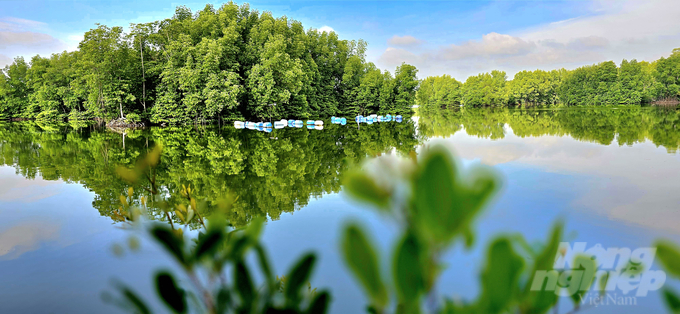
Dong Nai Province boasts a vast and diverse mangrove forest area with significant environmental value. Photo: Minh Sang.
Despite its focus on industrialization, Dong Nai Province boasts a vast and diverse mangrove forest area with significant environmental value. With the aim of promoting sustainable development, the province facilitates the allocation of forest land to local residents, enabling the establishment of livelihoods under the forest canopy that yield substantial economic benefits while simultaneously contributing to the conservation of both the forest and the environment.
Dong Nai houses nearly 8,000 hectares of mangrove forest area in Long Thanh and Nhon Trach districts. These lush mangroves have provided coverage for the land, and supported local households who rely on the forest's resources to establish natural aquaculture practices.
The majority of local aquaculture models follow extensive and ecological farming methods, locally known as ponds for shrimp, crabs, and fish. Local farmers adopt a relatively simple farming practice by releasing shrimp, crabs, oysters, and brackish water fish into the natural environment. Farmers primarily introduce juvenile stock into the natural water environment, allowing the aquatic species to forage their own food. Consequently, the quality of the shrimp, crabs, and fish raised in these ponds is indistinguishable from that of wild-caught seafood, resulting in high economic value and strong market demand.
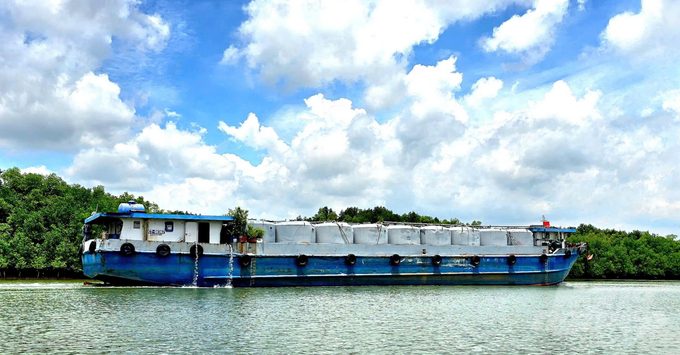
Large cargo ships navigate the Dong Tranh, Dong Kho, and Long Tau rivers, transporting goods to and from Cai Mep Port and Dong Nai Port. Photo: Minh Sang.
Luu Nhat Nam, a fisherman who has engaged in both fishing and extensive aquaculture for nearly 10 years in Phuoc An Forestry Station, Nhon Trach District, invited us to his extensive shrimp and crab farming ponds. He shared, "With this model, I release juveniles and provide supplementary feeding only when they are small. After releasing them into the pond, the fish can find natural food to grow."
According to Nam, compared to intensive farming, the extensive farming model requires additional time investment, and the yield is significantly lower. Farmers gradually harvest shrimp, crabs, and fish from the pond instead of in batches. Accordingly, they collect only fish that meet market standards each day. Nam harvests only a few dozen kilograms per day on average, which is insufficient to meet the demand from tourists.

Luu Nhat Nam has been engaged in fishing and extensive aquaculture for nearly 10 years at Phuoc An Forestry Station, Nhon Trach District. He harvests only a few dozen kilograms daily from his ponds, which is insufficient to meet the demand from tourists. Photo: Minh Sang.
Fishermen in Nhon Trach District have reported that the local natural supply of brackish water seafood was previously abundant; however, the yield of wild aquatic species has been on a steep decline in recent years. As a result, extensive farmed seafood has increased significantly in demand, with consumers willing to pay premium prices for these specialties. Shrimp, crabs, and fish from the brackish water ponds are primarily supplied to restaurants at high prices, catering to the growing demand, especially from tourists.
Tran Hoang, a brackish water crab farmer using the extensive farming model in Long Phuoc Commune, Long Thanh District, shared, "I typically catch and sell various types of shrimp and crabs at a stable price ranging from 300,000 to 500,000 VND per kilogram. During September and October, we are in the peak season for crabs with high roe content, which are considered the most delicious. Crabs with roe fetch prices that are 100,000 to 200,000 VND per kilogram higher than regular meat crabs."

Local residents preparing fishing gear to catch wild fish in the ponds and rivers under the mangrove forest canopy. Photo: Minh Sang.
According to Hoang, the region's advantage lies in its proximity to major urban areas and the future international airport, which removes concerns over market access for the local specialties. As a result, despite the presence of major brackish water seafood collectors, his family primarily sells directly to individual customers or supplies local restaurants. Additionally, there is a high demand from individual buyers, particularly tourists, who visit the ponds to purchase these specialties.
The majority of local households engaged in fishing within the mangrove forests of Long Thanh and Nhon Trach districts started as poor migrants who relied on exploiting the forests, especially fishing in the brackish water areas. As natural seafood resources became increasingly scarce, their livelihoods faced significant challenges. The aquaculture model under the forest canopy has provided a sustainable solution for forest development, offering dual benefits by creating livelihoods for residents and contributing to environmental protection.
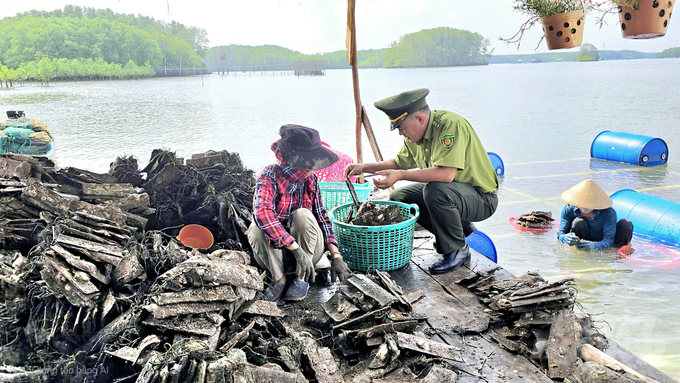
The mangrove forest protection force under Dong Nai Province’s Department of Forest Protection frequently patrols and visits the aquaculture models belonging to households contracted to protect the forest. Photo: Minh Sang.
According to households contracted in Long Thanh and Nhon Trach districts, extensive aquaculture under the forest canopy yields lower profits compared to industrial shrimp farming. However, this model requires minimal investment and labor. Furthermore, it can adapt to the increasingly unpredictable weather conditions.
Nguyen Thanh Trung, a resident of Phuoc An Commune, Nhon Trach District, manages 9.8 hectares of shrimp, crab, and oyster farming area under the mangrove canopy, which includes 5 hectares of water surface for aquaculture and 3.8 hectares of forest area. The current erratic weather conditions have made aquaculture less favorable compared to previous years. However, farmers do not face the same risk of total loss as those involved in industrial shrimp farming, which is susceptible to disease outbreaks. In exchange for rapid wealth accumulation, the model provides relatively stable income, allowing farmers to maintain their livelihoods with confidence.
“Due to the natural farming environment, diseases rarely affect shrimp, crabs, or fish, unlike in industrial farming. We almost never use antibiotics, relying instead on biological products, which helps prevent environmental pollution. As a result, the quality of seafood from the extensive farming model is excellent, with exceptional food safety. Seafood collectors often immediately buy all of our harvest,” Trung explained.
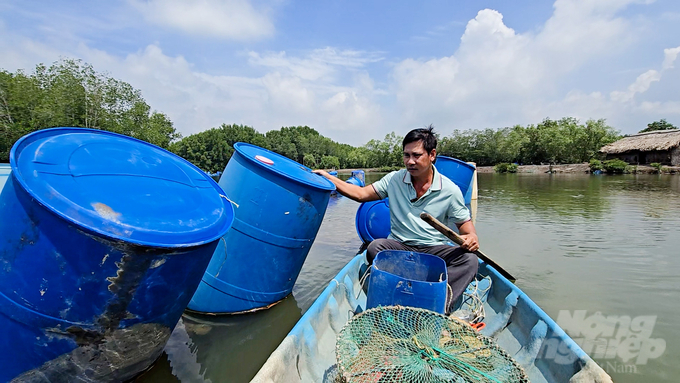
Nguyen Thanh Trung, a contracted forest protector with over 20 years of experience in Phuoc An Commune, Nhon Trach District, currently manages 9.8 hectares of aquaculture under the mangrove canopy. Photo: Minh Sang.
In addition to shrimp and fish farming, local residents under the forest canopy also utilize the water from the Dong Tranh, Dong Kho, and Long Tau rivers to farm oysters, a mollusk with high economic value in today’s market.
Floating oyster farms can be found littered along the 2-kilometer stretch of river. The majority of these farms belong to farmers from other regions, whereas a smaller number belong to local residents from Phuoc An and Long Tho communes in Nhon Trach District.
Local authorities, particularly the Long Thanh Protection Forest Management Board, are responsible for managing and protecting the mangrove forests, as well as supporting residents in developing aquaculture models under the forest canopy. Le Dang Khanh, Head of the Phuoc An Forestry Station, noted, "The local river fishermen are close partners with the forest rangers at the Long Thanh Protection Forest Management Board. Stable mangrove forest development creates a thriving environment for aquatic life. As a result, residents living in the mangrove forest areas also take greater responsibility in protecting and preserving these forests.”
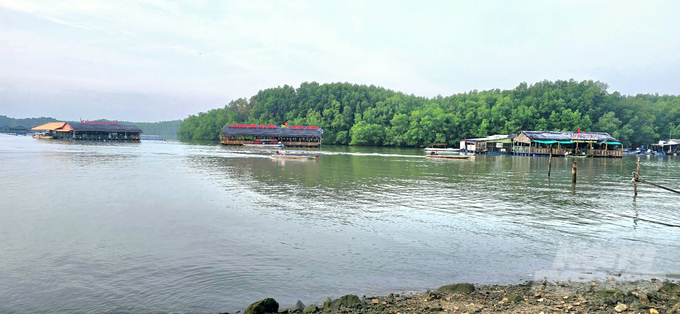
Local residents primarily supply brackish water shrimp, crabs, and fish raised in extensive farming systems to restaurants along the river at high prices to meet the demand from customers, especially tourists. Photo: Minh Sang.
According to Khanh, this farming method allows residents to protect the forest in addition to maintaining ecosystem balance, causing minimal environmental impact. This approach reflects the commitment of local residents to respecting and preserving their ecological environment.
Each time we observe the interaction between the forest protection force and local residents, the warm greetings and lighthearted banter demonstrate a strong bond among those who live year-round alongside the forest and waterways. For them, the forest is home—a priceless asset bestowed by nature.
Translated by Nguyen Hai Long

(VAN) FAO’s Director-General addresses the 5th Baghdad International Water Conference.
/2025/05/26/1716-4-nongnghiep-191706.jpg)
(VAN) Chain linkages, technological innovation, and raw material zoning are three strategic pillars for the coconut industry to strongly develop and elevate its position on the global agricultural map.
![Advanced mariculture – an inevitable trend: [4] Accompanied by scientists](https://t.ex-cdn.com/nongnghiepmoitruong.vn/608w/files/sohk/2025/05/13/1941-pgsts-vo-van-nha-140958_717.jpg)
(VAN) According to Assoc. Prof. Dr. Vo Van Nha, Director of the RIA III, the development of advanced offshore mariculture is no longer an option but an essential path for Vietnam’s fisheries sector.
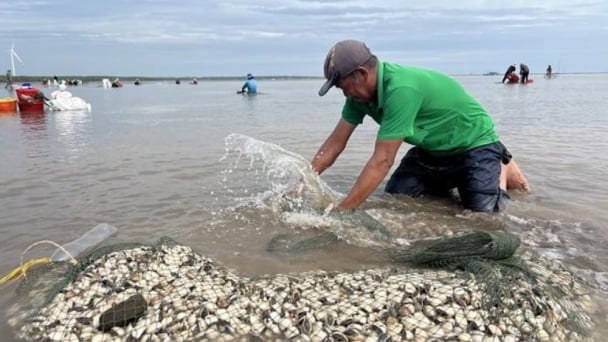
(VAN) Vietnam is intensifying the development of mollusk farming areas that meet international standards, aiming for sustainable growth and enhancing its export position in the global seafood market.
![Advanced mariculture – an inevitable trend: [3] Policy-driven momentum](https://t.ex-cdn.com/nongnghiepmoitruong.vn/608w/files/doanhtq/2025/05/21/0104-0616-0348-nuoi-bien-170339_789.jpg)
(VAN) To ensure the success of offshore mariculture that uses advanced technologies, it is essential to establish supportive policies that inspire both individuals and enterprises to invest with confidence.
![Advanced mariculture – an inevitable trend: [2] Outstanding results](https://t.ex-cdn.com/nongnghiepmoitruong.vn/608w/files/sohk/2025/05/12/4632-4136-nuoi-bien-11-164117_819.jpg)
(VAN) Pilot models of high-tech offshore mariculture in Vietnam, particularly in the South Central Coast region, have demonstrated exceptional economic returns and sustainability, setting a new direction for the country’s aquaculture industry.
![Advanced mariculture – an inevitable trend: [1] Moving offshore](https://t.ex-cdn.com/nongnghiepmoitruong.vn/608w/files/phucpm/2025/05/18/0252-2436-nuoi-bien-6-162148_783.jpg)
(VAN) Mariculture using advanced technology and moving offshore is an inevitable trend, as nearshore areas increasingly reveal limitations.